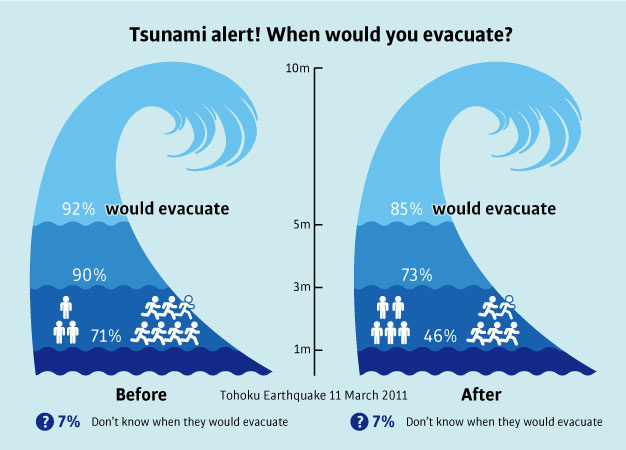Understanding how people perceive risk during natural disasters could save lives
Published online 26 May 2016

Japanese perceived waves under 10 meters high to be less risky after experiencing the magnitude-9 earthquake and 40-meter high tsunami that hit Tohoku on 11 March 2011.
© 2016 Satoko Oki, Keio University
Everyone in Japan knows what to do when the Earth begins to shake ― the small island-nation sits above one of the world's most seismically active regions. While this familiarity with earthquakes helped save many lives in the 2011 Tohoku earthquake, it also caused many to underestimate the danger of being hit by a tsunami. An estimated 19,000 people died in the Tohoku disaster, more than 14,000 from drowning.
Satoko Oki, a geophysicist at Keio University's Faculty of Environment and Information Studies, has studied the Japanese public's response to the earthquake and come up with some unexpected observations about how the brain processes risk. Her research will help to improve communication and education in an earthquake-savvy community.
Paradox of perception
Oki was a teenager when in 1995 a devastating earthquake hit Kobe city, killing more than 6,000 people. She spent hours glued to the television news coverage of the disaster unfolding. It was then she decided to become a seismologist, but not just any seismologist. Oki wanted to engage the public in her work.
In 1981, Japan introduced more stringent standards for new buildings to be constructed to withstand ground motion of magnitude 7 or higher. People living in coastal areas are also advised to evacuate to higher grounds to escape an impending tsunami. "We don't know when the 'big one' will occur, but we already know how to survive," says Oki.
Oki wanted to know what height of tsunami the general public thought presented a serious threat. In 2010, about a year before the Tohoku quake, she conducted a survey of more than 2,000 people, providing answer choices from 'don't know' to 'more than 10 centimeters' to 'more than 5 meters'.
To help explain the results, Oki sought the advice of Kazuya Nakayachi, a psychology researcher at Doshisha University in Kyoto. Before they had an opportunity to analyze the data, however, the magnitude 9 earthquake hit.
About a month after the quake, Oki and Nakayachi surveyed 1,036 participants and compared their answers to those of 733 respondents in the same prefectures from the previous survey. Oki assumed that the participants, out of fear of reliving the harrowing experience, would be ready to evacuate for smaller tsunamis. Nakayachi instead, "assumed that their risk perception would decrease," recalls Oki. The survey data validated Nakayachi's hypothesis (see image), which was based on a psychological model known as the anchoring effect1.
The anchoring effect describes how people judge data in relation to a previously known value, and either inflate or diminish it. In the case of the tsunami survivors, having just witnessed a 40-meter-high wave, many believed a 3-meter-high wave, which is still capable of ripping a house apart, to be 'no big deal'.
Unfortunately, people love reporting record-breaking events ― from the fastest 100-meter sprint to the largest collection of gnomes. Oki cautions that for natural disasters, to somewhat mitigate this anchoring effect, records should be accompanied with a baseline, such as a 1-meter-high tsunami ― "which is still dangerous."
Finite pool of worry
The Tohoku earthquake also caused one of the world's worst nuclear accidents at the Fukushima Daiichi power plant. Oki and Nakayachi went on to investigate whether the high level of public anxiety around earthquakes and radioactive contamination following Tohoku affected the way people felt about other unrelated hazards2. They compared survey results from 2008 and 2012 for changes in public anxiety about 51 hazards ranging from nanotechnology to international conflict. Overall anxiety about these hazards decreased significantly, in a manner not commensurate with the larger loss of life associated with them. The lowered risk perception for other hazards in the wake of a severe natural disaster could dilute harm-reduction measures, warn Oki and Nakayachi.
In April 2016 Japan was hit with another powerful series of shakes in southern Kumamoto. Oki is keeping a close eye on the public communication. "It is not enough to conduct research into earthquake science, we also need to develop our communication skills to improve public awareness and promote preparation," she says.
References
-
Oki, S & Nakayachi, K. Paradoxical effects of the record-high tsunamis caused by the 2011 Tohoku earthquake on public judgments of danger. International Journal of Disaster Risk Reduction 2, 37-45 (2012). | article
-
Nakayachi, K., Yokoyama, H. M. & Oki, S. Public anxiety after the 2011 Tohoku earthquake: fluctuations in hazard perception after catastrophe. Journal of Risk Research 18, 156-169 (2015). | article